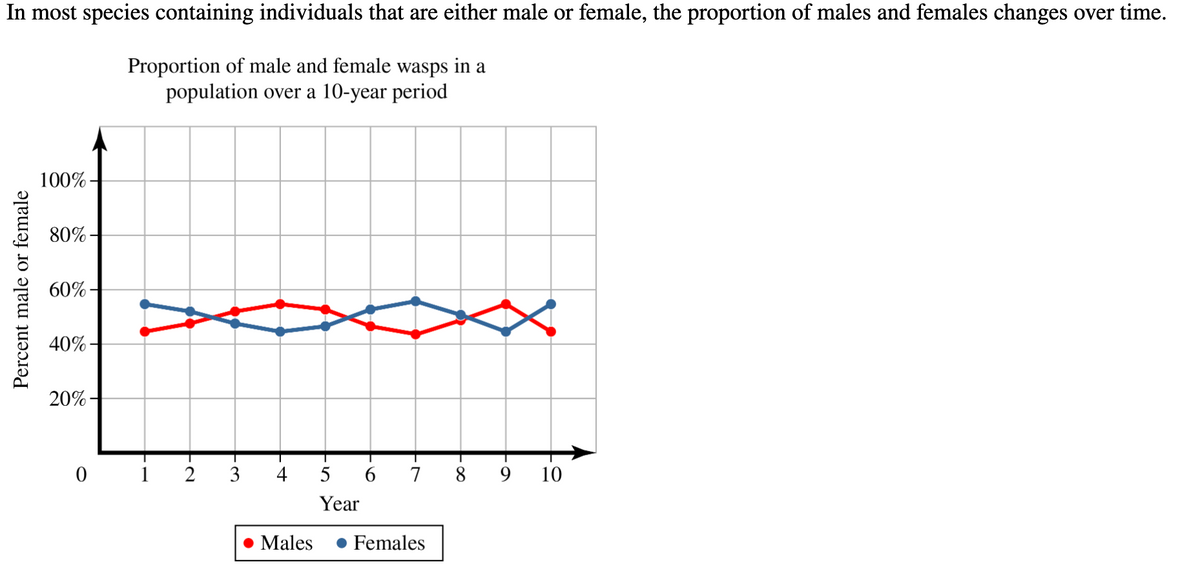Based on the data shown in the graph, select the statements that describe what happens whenever one sex becomes rare or common. When one sex becomes rare, parents producing that sex have higher fitness due to a higher probability of mating success in their offspring. The rare sex becomes more common. When one sex becomes common, parents producing that sex have reduced fitness due to a lower probability of mating success in their offspring. The common sex becomes rarer. When one sex becomes rare, the other sex becomes common due to random fluctuations in the production of male and female offspring. The fitness of the parents is not affected. When one sex becomes either more rare or more common, parents produce an equal number of sons and daughters. The sex ratio returns to an equal number of males and females.
Based on the data shown in the graph, select the statements that describe what happens whenever one sex becomes rare or common. When one sex becomes rare, parents producing that sex have higher fitness due to a higher probability of mating success in their offspring. The rare sex becomes more common. When one sex becomes common, parents producing that sex have reduced fitness due to a lower probability of mating success in their offspring. The common sex becomes rarer. When one sex becomes rare, the other sex becomes common due to random fluctuations in the production of male and female offspring. The fitness of the parents is not affected. When one sex becomes either more rare or more common, parents produce an equal number of sons and daughters. The sex ratio returns to an equal number of males and females.
Biology 2e
2nd Edition
ISBN:9781947172517
Author:Matthew Douglas, Jung Choi, Mary Ann Clark
Publisher:Matthew Douglas, Jung Choi, Mary Ann Clark
Chapter45: Population And Community Ecology
Section: Chapter Questions
Problem 9RQ: Which of the following is associated with multiple reproductive episodes during a species’ lifetime?...
Related questions
Question
Based on the data shown in the graph, select the statements that describe what happens whenever one sex becomes rare or common.
When one sex becomes rare, parents producing that sex have higher fitness due to a higher probability of mating success in their offspring. The rare sex becomes more common.
When one sex becomes common, parents producing that sex have reduced fitness due to a lower probability of mating success in their offspring. The common sex becomes rarer.
When one sex becomes rare, the other sex becomes common due to random fluctuations in the production of male and female offspring. The fitness of the parents is not affected.
When one sex becomes either more rare or more common, parents produce an equal number of sons and daughters. The sex ratio returns to an equal number of males and females.

Transcribed Image Text:In most species containing individuals that are either male or female, the proportion of males and females changes over time.
Proportion of male and female wasps in a
population over a 10-year period
100%
80%-
60%
40%
20%
0 1
2
3
4
5 6
7
8 9
10
Year
Males
• Females
Percent male or female
Expert Solution
This question has been solved!
Explore an expertly crafted, step-by-step solution for a thorough understanding of key concepts.
This is a popular solution!
Trending now
This is a popular solution!
Step by step
Solved in 3 steps

Recommended textbooks for you

Biology 2e
Biology
ISBN:
9781947172517
Author:
Matthew Douglas, Jung Choi, Mary Ann Clark
Publisher:
OpenStax

Biology 2e
Biology
ISBN:
9781947172517
Author:
Matthew Douglas, Jung Choi, Mary Ann Clark
Publisher:
OpenStax